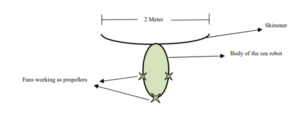In the new technological era, utilization of machinery has had a greater impact on the environment. In a positive as well as in a negative way. In recent years of advancement, we have heard about various technologies being established all around the world. Water pollution has been a profound issue in the last decade.
Oceans and seas surface areas are filled with huge amount of unwanted substances being a threat to the sea life and causing water pollution. this mainly consist of impurities like plastic, garbage on floating water surface and oils. These impurities mainly have an effect on life of aquatic animals.
There are various autonomous and semi autonomous technologies and machinery built up to help eradicate this problem. One of them is robots. Autonomous robots are intelligent machines capable of performing tasks in the world by themselves, without explicit human control. Submerged robots have been an arising research territory being at the convergence of the field of mechanical technology and maritime designing. Their applications incorporate ecological observing, oceanographic planning, and framework reviews in remote ocean.
Since oil is wellspring of energy utilized by practically all the business areas. The request of oil is expanding in a huge manner and is validated by extending submarine oil pipelines and circulation of oil and its subsidiaries by utilizing big haulers to carry it to numerous places. This builds the odds of oil spillage in the ocean either by spillage from submarine oil pipelines or mishaps with the big haulers. Such mis happenings lead to serious catastrophes of oil spillage in the high oceans. This compromises the untamed life in the ocean, so examination to tidying up oil slick rapidly and productively has become vital issue by scientists and organizations concerned.
For oil spills specifically, Robots used on sea water can navigate easier than mobile robots on the ground, however the obstacles in sea are very rare and that enables ship robots to maneuver and move easily and reaching destination fast. An organizer decides the position and focal point of the oil slick first utilizing a GPS recipient, at that point a freight boat conveying the robots move to the working spot. As per the situation with the oil slick (shape, zone covered, one spill or many, heading and speed of wind, and so on) the organizer can dispatch a multitude of robots to encompass and gather the oil slick, at that point the freight boat with an oil sucking hardware moves it for somewhere else to gather/arrange the oil in a more secure way. Every robot works in two modes, viz., self-ruling mode and controller mode. The majority of the plastic substances are enduring and debase gradually. This coasting plastic texture ventures a significant stretch in the sea. These coasting plastics get amassed inside the focal point of subtropical water flows, which prompts the arrangement of trash patches. These ocean flows meet at the middle and sink. In any case the coasting plastic materials stay at the surface, permitting it to gather in these regions. These Plastic materials can reason an entire eco-framework to fall assuming left uncollected. There are numerous approaches to clean water surface which need human intercession. The time spend by a government individual to clean the sea can be saved to do some beneficial work. Thus, it gets important to think of inventive plans to clean the garbage on the sea.


Keeping the sea clean each day is hard yet additionally a significant work. Trash and plastic developed all over on the water surface which are cleaned by utilizing colossal boats and machines one of which is “The Automatic Ocean Garbage Collector” created by implementing the concepts of various fields such as Embedded, Electric and Mechanical system as well as IOT cloud. At the point when the robot is turn on, it will follow the pre-customized way encoded. During this cycle it will check for trash skimming by all accounts. In the event that trash is identified the robot will stop furthermore, actuate the transport line, the movement of the transport will suck trash will itself and gather the trash in the holder. The amount of the gathered trash will be observed utilizing an ultrasonic sensor all through the process. If the holder gets full, the robot will stop identifying trash and follow the pre-customized way. Keeping the sea clean starting with one end then onto the next is a troublesome assignment, so for cleaning the ocean at the push of a button autonomous ocean garbage collector is designed. The robot can tidy up 1km of region in one interaction cycle. the robot is observing and information is shipped off the cloud in like clockwork. the robot is required to beat the trash fixes particularly in the sea.

Development of new technologies like these can help protect our natural resources for father sustainable utilization. In this new era of advancement, even thought development of new technologies will definitely have its own cons, but focusing on the pros much more profoundly can help us further eradicate environmental issues.

